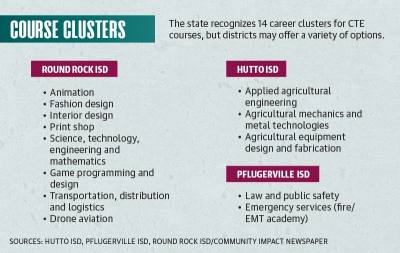Texas Workforce Commission labor market data shows industries such as construction, information, business and professional services will see near 50% increases in the number of available jobs in area counties including Travis and Williamson by 2028.
As these sectors grow, not every position will require a four-year degree. CTE directors at Round Rock, Pflugerville and Hutto ISDs all said they are experiencing increased interest in this type of education as industry leaders such as Tesla, Samsung and Apple invest in local operations.
“In the last few years, where engineering used to be the most popular, now computer science is,” RRISD Director of CTE Sheri Bonds said. “Because parents are hearing about that in the media, and they’re hearing about job openings, we’re seeing more students enrolling in computer science courses. There’s definitely a request and more of a desire for trades.”
CTE is offered to Texas high school students who want to begin pursuing a trade or explore interest in a certain field before graduation.
“The kids get that opportunity to try on a career and see if it really speaks to them or not,” said Peggy Mica, RRISD assistant director of CTE. “They have a better idea when they leave us what might be their next step.”
CTE pathways
Formerly known as vocational education, CTE courses are geared toward providing students with training and education for a career, regardless of whether it requires a four-year degree. Programs at Round Rock, Pflugerville and Hutto ISDs allow students to earn certifications that give them an advantage when beginning an apprenticeship, going to a trade school, attending a four-year college or heading straight into the workforce.Educators say CTE programs can provide easy and affordable access to trade programs and certifications and gain additional experience before attending an institution of higher education or working in their field after graduation.
Local programs are based on demands of the labor market and emerging industry, PfISD CTE Director Traci Hendrix said.
“We focus on partnering with business and post-secondary partners in the area and doing a lot of research on current opportunities,” Hendrix said. “Then we look at what opportunities are going to be arising in the next few years and build programs that allow students to start exploring [those] in middle school.”
Jodi Jacobson, an RRISD parent of three students, said the CTE program was a deciding factor in choosing the district. She said it has kept her children in Round Rock as she has recently gotten a new job in San Marcos.
“I make that commute daily,” Jacobson said. “Not just because of the comfort that my kids had built at Round Rock, but because of their very diverse interests, and knowing that Round Rock ISD has exactly the programs that they would want to be in and they would need.”
CTE programming falls into career clusters. For example, in PfISD, agriculture encompasses multiple courses of study, such as animal science, applied agricultural engineering and plant science. The Texas Education Agency recognizes 14 career clusters that school districts may further break down.
HISD students can choose courses from a selection of CTE-based offerings to take throughout their time in high school, slightly less structured than similar offerings in RRISD or PfISD.
PfISD students will similarly choose one or more programs of study to guide their course selection as high school students. Hendrix said students may change their programs of study at any time.
In RRISD, students will select an academy to guide their educational pursuits beginning in high school, with some academies geared toward CTE education and others driven by performing arts focuses. These academies are aligned with CTE pathways that set students on a course of study throughout their time as a high school student with several programs offering certification and internship opportunities in partnership with local businesses. As local CTE programs are evolving to meet the demands of changing industry, local data shows enrollment is also increasing.
From the 2019-20 school year to the 2020-21 school year, RRISD and HISD saw substantial upticks in CTE students with year-over-year enrollment at HISD up more than 54% in that time period.
Jacobson said RRISD’s CTE program has a variety of offerings that allow her children to explore their interests before choosing a career, getting ahead before they enter the workforce.
“These kids can walk in with this on a resume, showing that not only did they take this class, they have the certification,” Jacobson said. “I think those make a big impact on careers, whether they’re going more of a technical route or a college route.”
Post graduation
After graduating, students who have taken advantage of CTE offerings in high school may choose to attend a four-year college or university, attend a trade school, jump straight into an apprenticeship or otherwise enter the workforce directly.One local option, Texas State Technical College, offers multiple opportunities for students to build on skills developed in high school CTE courses. TSTC’s Williamson County campus, located in Hutto, offers a local option for students looking to begin their careers in trades. Associate Dean Nelson Adams said TSTC students have a placement rate of over 90%, meaning that over 90% of students who complete TSTC programs are able to find jobs in their selected field.
Adams also said students who work prior to graduating high school, whether in the field they intend to seek a career or in retail, are gaining a set of transferable skills that provide an additional edge post-graduation.
“They’re learning a valuable set of skills in that experience,” Adams said. “Those students that are working really hit the ground running and are able to pick up on those skills faster.”







